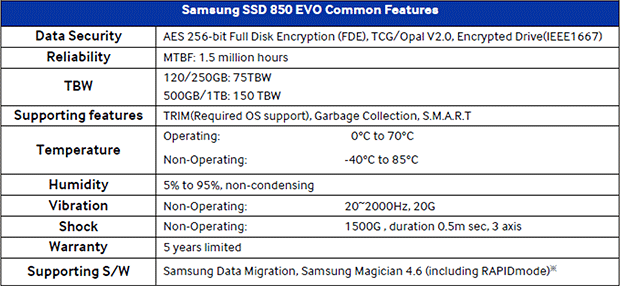Samsung SSD 850 EVO mSATA and M.2 Drives Reviewed
We’ve got a couple of drives in hand, a 500GB M.2 Samsung SSD 850 EVO and a 1TB mSATA slickster that would be right at home in a notebook or HTPC. The drives’ specification are below, followed by few glamour shots, and—of course—plenty of benchmarks...
|

Samsung will be offering SSD 850 EVO series drives with capacities ranging from 120GB all the way up to 1TB in mSATA flavors, but the M.2 models top out at 500GB. Like most other SSDs, performance varies between the different capacities, but overall the 850 EVO series’ specifications point to drives with class-leading performance, just like their 2.5” counterparts.
The drive you see pictured here is an SSD 850 EVO 500GB M.2 model. And as you can see, the PCB is tiny and relatively clean, packing only the controller, NAND, and a bit of memory.
We should mention that this drive (and the 120GB and 250GB models) feature dual-core Samsung MGX controller. The controller is fundamentally similar to the triple-core MEX controller used in the recently released 850 Pro series, though a core has been removed. Samsung claims it made this move in order to save power, because the extra core didn’t help performance on the lower capacity drives. Note, however, that the 1TB mSATA drive has an MEX controller. Since we’ve already mentioned power here, we should also point out that the 850 EVO series offers support for low-power Dev-Sleep mode, which can help extend battery life in mobile devices.
All of the Samsung 850 EVO series drives also feature some LPDDR2-1066 DRAM cache memory. The 120GB drive sports 256MB of cache, the 250GB and 500GB drive have 512MB of cache, and the 1TB drive has 1GB of cache. All of the Samsung 850 EVO drives are also outfitted with 32-layer 3D V-NAND 3bit MLC NAND flash memory of varying capacities. The 500GB drive you see here has four 128GB pieces of NAND. If you do the math, however, you’ll find that the drives leave roughly 9% of the NAND capacity for over-provisioning, which is typical of many current SSDs. Endurance ratings are relatively high thanks to the move to 3D V-NAND as well--the 120GB and 250GB drives are rated for 75 TBW, while the higher capacity 500GB and 1TB drives are rated for 150 TBW.
In addition to using 32-layer 3D V-NAND 3bit MLC NAND flash, Samsung has also dedicated a small portion of the NAND to act like an SLC write buffer—Samsung calls the feature TurboWrite. This allows the TLC NAND to perform more like a MLC drive for writes, as long as the buffer isn’t exhausted.
TurboWrite should allow the 850 EVO series to perform very well in the vast majority of consumer-class workloads, because writes are much faster when the TurboWrite buffer is being utilized, but its effect on performance can be a bit unpredictable.
Another interesting feature carried over from previous-gen drives is dubbed RAPID. RAPID is an acronym for Real-Time Accelerated Processing of I/O Data. It is a feature of Samsung’s Magician software (v4.2 or newer) that can speed up the drive significantly and can be enabled with a single-click (followed by a reboot).
Samsung acquired software developer NVELO a while back, which was a company known for its SSD caching technology. NVELO’s software was used to accelerate hard drive transfers by buffering the most commonly accessed bits of data from the hard drive onto a faster SSD. Well, RAPID works in a similar manner, but in the case of the Samsung 850 EVO series of drives, RAPID caches the most commonly accessed bits of data on the SSD into faster system memory. The size of the cache will dynamically adjust based on available system resources, and it follows the cache flush commands of the OS, so the risk of losing data due to an unexpected power outage isn’t much higher than a typical system using write buffering. The algorithms for RAPID are specifically tuned for solid state transfers, however, and are far more effective than any current-gen OS cache.









